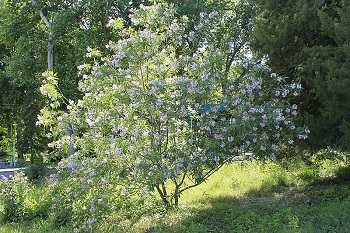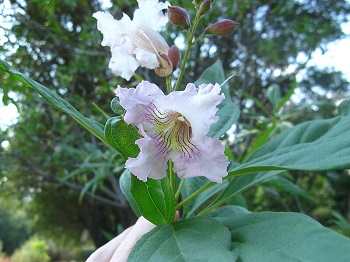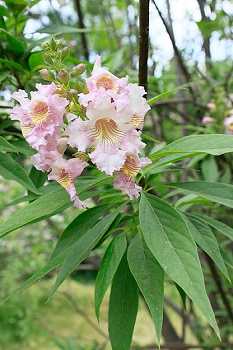If you are searching for Chitalpa Tree Pros and Cons, before that let me tell you chitalpa tree, a cross between the southern catalpa and desert willow, has several advantages for landscape designers and gardeners. It has become more well-liked in a variety of climes because to its distinctive qualities and flexibility. It does, however, have a unique set of disadvantages, much like every other tree. In this article, we will explore the Chitalpa tree pros and cons, shedding light on its advantages and potential challenges.
| Pros | Cons |
|---|---|
| Drought Tolerance | Aphid Infestation |
| Fast Growth | Root Rot and Wilt |
| Attractive Flowers | Fruit and Staining |
| Ornamental Appeal | Overpowering Smell |
| Low Maintenance |
Pro: Drought Tolerance
The amazing capacity of the Chitalpa tree to flourish in dry and desert-like settings makes it stand out. It is an excellent choice for areas with little water supplies because of its exceptional resistance to drought. If given the right care and attention, the Chitalpa tree may thrive even in locations where water supply is an issue.
The deep and broad root system of the Chitalpa tree is one of the main factors contributing to its capacity to withstand drought. These roots provide the tree access to water in deeper soil layers, which are often higher in moisture. Additionally, the Chitalpa has developed adaptations to lessen water loss via its leaves, including as tiny, waxy leaf surfaces, a reduction in stomatal density, and the capacity to seal its stomata during dry seasons. These modifications aid the tree’s ability to save water and endure dry circumstances.
It’s essential to take the necessary precautions to guarantee the Chitalpa tree’s success in areas that often experience drought. These trees can tolerate a variety of soil types, including ones with poorer water-holding capacities, however they do prefer well-drained soil. Mulching the area surrounding the tree’s base and routine heavy watering during dry times might boost its resistance and general health.
Also Read :
As an Amazon Associate we earn from qualifying purchases.
Table of Contents
Redbud Trees Pros and Cons – 12 Facts You Need to Know
Celebration Maple Tree Pros And Cons – 8 Facts You Need to Know
Brandywine Maple Tree Pros And Cons – 7 Facts You Need to Know
Purple Robe Locust Tree Pros and Cons – 10 Important Facts
River Birch Tree Pros and Cons – 16 Facts You Need to Know
Hickory Tree Pros and Cons: 7 Facts You Need to Know
Hazelnut Tree Pros and Cons – 10 Facts You Need to Know
October Glory Maple Tree Pros And Cons – 9 Amazing Facts
Pro: Fast Growth

The term “chicken” refers to a plant that is grown in a greenhouse. These trees have the capacity to take root fast and grow to significant heights in a rather short amount of time.
The Chitalpa tree grows quickly due to a number of causes. Rapid development is possible because to its sturdy branching structure and active growth habit. The tree’s capacity to sprout several branches from its base further accelerates its pace of development. The Chitalpa tree also has a strong ability for photosynthetically converting sunlight into energy for growth and development.
Chitalpa trees not only grow quickly but are also aesthetically pleasing. They generate profusions of colorful, trumpet-shaped flower clusters that bloom profusely throughout the summer, bringing a splash of color to the surroundings. The tree’s thick foliage offers protection from the sun and makes a comfortable setting for outdoor activities.
Chitalpa trees may swiftly rise to prominence in gardens, parks, and other green places due to their rapid growth. This feature is especially helpful in urban environments where there is a pressing need to develop a mature and aesthetically pleasing environment in a constrained amount of time. However, since Chitalpa trees may grow to be fairly huge, it is crucial to take into account the tree’s eventual size and provide enough room for its development.
Pro: Attractive Flowers
Chitalpa trees are well renowned for their capacity to produce gorgeous, colorful blossoms that enhance the attractiveness of any garden or landscape. Depending on the cultivar, these blooms appear in a variety of hues, such as pink, white, and lavender tones. The petals’ engaging display and eye-catching appearance quickly improve the surroundings’ overall beauty.
The Chitalpa tree’s lovely blossoms have a number of uses. First of all, garden aficionados find them to be aesthetically stunning and much sought after because to their vivid colors and exquisite petal shapes. These flowers become the garden’s focus points, attracting attention and enhancing the area’s air of sophistication. The blossoms of the Chitalpa add to the attractiveness of the environment, whether they are planted alone or as a group in mixed flowerbeds.
The Chitalpa tree’s blossoms are not only beautiful, but they also contribute significantly to biodiversity. With their nectar-rich flowers, they attract a variety of pollinators, including bees and butterflies. These pollinators help diverse plant species reproduce and spread, which improves the ecological balance and wellbeing of the surrounding area. The Chitalpa tree fosters the ecosystem’s general health and fosters a flourishing environment for beneficial insects by luring pollinators.
Pro: Ornamental Appeal

Chitalpa trees feature a natural decorative appeal that improves the visual effect of gardens and outdoor areas with their characteristic oval-shaped canopy and lovely foliage. Their leaves’ distinctive shapes give them a distinct look that is aesthetically appealing and provides an intriguing feel.
In gardens and outdoor lounging spaces, the Chitalpa tree’s canopy produces dappled shade, fostering a welcoming atmosphere. The soft dance of light and shadow created by the filtered sunlight filtering through the leaves gives the scene depth and intrigue. It is the perfect place for relaxation and pleasure since this natural shade effect not only improves the visual appeal but also offers a cozy haven from the sun’s powerful beams during the hot summer months.
Chitalpa trees have a remarkable decorative appeal that makes them excellent garden focal pieces or backdrops for other landscaping components. They add to the overall composition of the garden with their beautiful shape and lovely leaves, which provide a feeling of harmony and balance. The Chitalpa tree’s decorative qualities make it a flexible addition to any outdoor environment, whether planted alone or in groups.
The Chitalpa tree is well suited for many landscaping projects because to its tolerance to various soil types and environmental factors. It may be used in a variety of garden designs, including more formal and structured layouts as well as more organic and free-flowing landscapes. Because of its adaptability, it may go well with other garden components like sculptures, water features, or sitting places, giving the composition more depth and aesthetic intrigue.
Pro: Low Maintenance

Chitalpa trees are well known for being low-maintenance, which makes them a great alternative for anyone who want hassle-free landscaping solutions or who lead busy lives. Once established, these trees need little maintenance, enabling homeowners to easily take in their beauty.
The capacity of Chitalpa trees to adapt to many soil types is one of its most notable qualities. As long as the soil is well-draining, they may grow in a variety of soil types, including sandy, loamy, and clay soils. Chitalpa trees are adaptable, making them excellent for a variety of garden settings, whether in urban, suburban, or rural regions. They make planting easier by requiring less intensive soil preparation and continuous soil management because to their resilience to various soil conditions.
Furthermore, Chitalpa trees resist common pests and diseases well, requiring less treatments overall. Chitalpa trees have evolved natural defenses that enable them to withstand or fight pests and diseases, even though no tree is completely immune to these threats. This resilience results in less need for chemical treatments or pest control methods, supporting horticulture that is sustainable and kind to the environment.
Chitalpa trees are low-maintenance, which is especially useful for those with hectic schedules or those who wish to keep their landscapes tidy. These trees need less regular watering than more water-dependent plants since, once established, they can primarily rely on natural rainfall. They are resilient generally and need little care due to their capacity to adapt to various soil types and their lower water requirements.
Chitalpa trees have minimal care needs in addition to aesthetic advantages that improve the appeal of any landscape. They have lovely foliage with long, elongated leaves that give them a beautiful, appealing look. They are great for establishing cozy outdoor areas or offering protection from the sun’s intensity during the hot summer months because to the thick canopy that offers shade.
In addition, Chitalpa trees produce clusters of colorful flowers in a range of hues, including pink, white, and lavender. These flowers provide the environment a splash of color and attract pollinators like bees and butterflies, which increases the garden’s biodiversity.
Con: Aphid Infestation

Chitalpa trees are prone to aphid infestations, especially during warmer months. These tiny insects consume the tree’s sap, which may impair the tree’s beauty and hinder its development. In order to manage aphid numbers and lessen their negative effects on Chitalpa trees, it is essential to periodically monitor these trees and adopt effective pest management techniques.
Since aphids are notorious for their quick reproduction, ants drawn to the sticky residue they leave behind, known as honeydew, are good indicators of their existence. Vigilant monitoring is required to lessen the impact of aphid infestations. Examine the tree’s leaves often, keeping an eye out for symptoms like twisted or deformed leaves, yellowing, or stunted development. Early discovery permits early action, which may include applying horticultural oils or insecticidal soaps to manage aphid populations or utilizing beneficial insects like ladybugs or lacewings that feed on aphids. To guarantee safe and reliable pest control techniques, it is essential to adhere to suggested rules and seek expert assistance when necessary.
Con: Root Rot and Wilt
Infections like root rot and wilt, which may seriously harm the root structure of a Chitalpa tree, can also affect these trees. These issues might lead to symptoms including leaf burn, wilting, defoliation, and, in extreme circumstances, even the death of the tree.
Typically, fungal infections that cause the roots to deteriorate and lose their ability to function are what cause root rot. It often happens in soil that doesn’t drain well or as a consequence of overwatering, since too much moisture fosters the development of fungi. On the other hand, soilborne fungi that infect the tree’s vascular system and obstruct the passage of water and nutrients are the cause of verticillium wilt. Foliage health suffers as a result, and withering occurs.
Proper soil drainage is essential to avoid soggy conditions that encourage fungal development and is necessary to prevent or treat these illnesses. Make careful to plant Chitalpa trees in well-draining soil and to refrain from overwatering. Check the tree often for any indications of wilting, leaf discolouration, or defoliation since these might point to root rot or wilt. When in doubt, it’s best to visit an arborist or tree care specialist for a precise diagnosis and the best course of action.
A common component of root rot and wilt management measures is enhancing soil drainage, modifying watering routines, and introducing cultural behaviors that support tree health. Fungicides may be suggested in extreme circumstances to manage the illnesses. It is essential to act quickly to stop the spread of these illnesses and maintain the general well-being and lifespan of Chitalpa trees.
Con: Fruit and Staining
A cluttered environment might result from the fruit that certain Chitalpa tree types yield. These fruits might end up on the ground, necessitating extra upkeep and cleaning procedures. The fruits may also leave stains on concrete surfaces, such pathways or driveways, if they are walked on or crushed, which may call for further care and cleaning.
It is advised to use fruitless cultivars of Chitalpa trees to preserve a tidy and fruitless environment. These varieties don’t bear fruit, so there’s no need to worry about fruit stains or litter. Selecting appropriate fruitless cultivars that are well-suited to the particular location and its climatic circumstances might benefit from the advice of local nurseries or horticulture experts.
There are steps that may be done to control the potential mess for those who already have Chitalpa trees in their landscape that are in fruit and are coping with the problem of falling fruits. Maintaining the space regularly and clearing away any fallen fruit will help maintain it neat. To quickly remove any fruit that has fallen to the ground, this may include raking or sweeping. Additionally, during the fruiting season, putting a protective barrier under the tree, such as a tarp or ground cover, may assist catch the falling fruits and make cleaning easier.
Con: Overpowering Smell
Some Chitalpa tree species produce fragrant blossoms that some people could find overwhelming, especially those who are sensitive to strong aromas. Even while many people find the aroma to be pleasing, it’s vital to take into account any possible effects, particularly when placing Chitalpa trees next to homes or outdoor dining places.
It is advised to choose your planting spot for a Chitalpa tree carefully to reduce any discomfort brought on by strong smells. People who are sensitive to strong odors may be less affected by the perfume by placing the tree further away from trafficked areas or selecting cultivars with lower fragrances.
It is important to note that not all varieties of Chitalpa trees produce strong fragrances. It is possible to find cultivars that have been intentionally cultivated to have less aroma, making them more acceptable for those who are sensitive to strong odors. When choosing Chitalpa tree varieties with softer scents that suit individual tastes, researching nurseries or asking local specialists, including arborists or horticulturists, may be quite helpful.
Conclusion
The Chitalpa Tree Pros and Cons, making it an appealing choice for many landscapers and garden enthusiasts. It is well-liked in a variety of regions because of its drought tolerance, quick growth, lovely blossoms, and minimal care needs. When selecting this tree for landscaping projects, possible issues including aphid infestations, illnesses such root rot and wilt, fruit and discoloration, as well as the strong scent of certain types, should also be taken into mind. People may guarantee the proper integration of the Chitalpa tree into their outdoor areas by evaluating the advantages and disadvantages and then making an educated choice.
Related Posts:
Purple Robe Locust Tree Pros and Cons – 10 Important Facts
River Birch Tree Pros and Cons – 16 Facts You Need to Know
Hickory Tree Pros and Cons: 7 Facts You Need to Know
Hazelnut Tree Pros and Cons – 10 Facts You Need to Know
October Glory Maple Tree Pros And Cons – 9 Amazing Facts
© 2024 Lotusmagus.com. All rights reserved. This content is protected by copyright. Visit Lotusmagus.com for more information.
